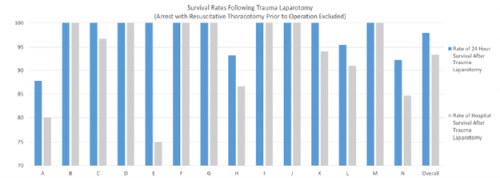Level I and II trauma centers are frequently asked to accept patients who need a higher level of care. This necessitates an inter-hospital transfer that is subject to scrutiny by the trauma performance improvement program of both trauma centers. The practice at many centers is to bring all transfer patients in through the emergency department. But is this really necessary?
Bringing Patients To Your Emergency Department
-
Patients can be reassessed to see if they meet any of your trauma activation criteria.
-
The work-up from the referring hospital can be re-evaluated. If some testing or imaging has been omitted, it can be obtained after arrival.
-
Specialist assessment may be more timely or may involve interventions that are more difficult after leaving the ED. Here’s an example. In some hospitals, orthopedics may choose to place a traction pin to provide initial fracture management. They may choose to use sedation, which may not be as readily available on a surgery ward.
-
Access to certain critical services may be more rapid from the emergency department. A patient may be more rapidly taken to the operating room or interventional radiology if the patient is in the emergency department.
-
It is easier to determine the correct admitting service in the ED prior to the actual admission. Sometimes patients are suitable for admission to a surgical subspecialist service, or to a medical service if they have complex comorbidities. Initial admission to the correct service from the ED is easier than later transfer.
But there are a few downsides to ED arrival:
-
The emergency department may be swamped. Taking a patient who could just as easily have been admitted directly increases congestion in the ED and slows throughput even further.
-
There is a built-in time delay going through any emergency department. You can count on patients spending eight hours, if not much, much more if they come to the ED first.
-
It’s a big dissatisfier for patients. They’ve already gone through this time-intensive process once and are usually not happy to have to do it again.
Direct Admissions
Direct admissions essentially reverse the pros and cons listed for emergency department evaluation.
There is a mistaken belief that the ACS Verification Review Committee looks askance direct admissions. This is not the case, and there are no criterion deficiencies that refer to them. Direct admits may be reported on the site visit pre-review questionnaire, and the reviewers may have questions about your numbers and how you identify them. Otherwise, each center is free to choose how they handle them.
Here are some guidelines for directing incoming patients to the most appropriate place.
-
Are you familiar with the referring physician or APP? If you have worked with them before and are confident of their evaluation skills, then a direct admission could be appropriate.
-
Is the referring hospital a trauma center, and are you familiar with how they work up patients? What has your previous experience with them been? Again, if they are part of your hospital system and/or you have had successful direct admissions from them in the past, consider it again.
-
Will the patient need rapid access to specialized services after arrival? Do they need to go to the operating room quickly? Or might they need advanced imaging that can be arranged more expeditiously from the ED?
-
Will they need any procedures after arrival that are more easily done in your ED? Do they need a complicated laceration repair best done with equipment in the ED? Will they require conscious sedation for a procedure?
-
Are you unsure of the most appropriate admitting service? Does the patient have significant comorbidities? Do you have two or more potential admitting services but just need to lay eyes on the patient to help you decide?
-
How busy is your ED? The longer the wait time, the more desirable it is to just skip it altogether, especially if none of the items above apply.
But make sure that you are able to accurately identify and track each and every direct admission coming into the hospital. Although high numbers of direct admission patients is not a violation of ACS standards, allowing trauma patients to get into the hospital on non-trauma services without being identified by the PIPS program is. I recommend that you review each and every one of them shortly after they arrive. Then make sure the decision-making was correct and the patient is on the service that best meets their needs.


